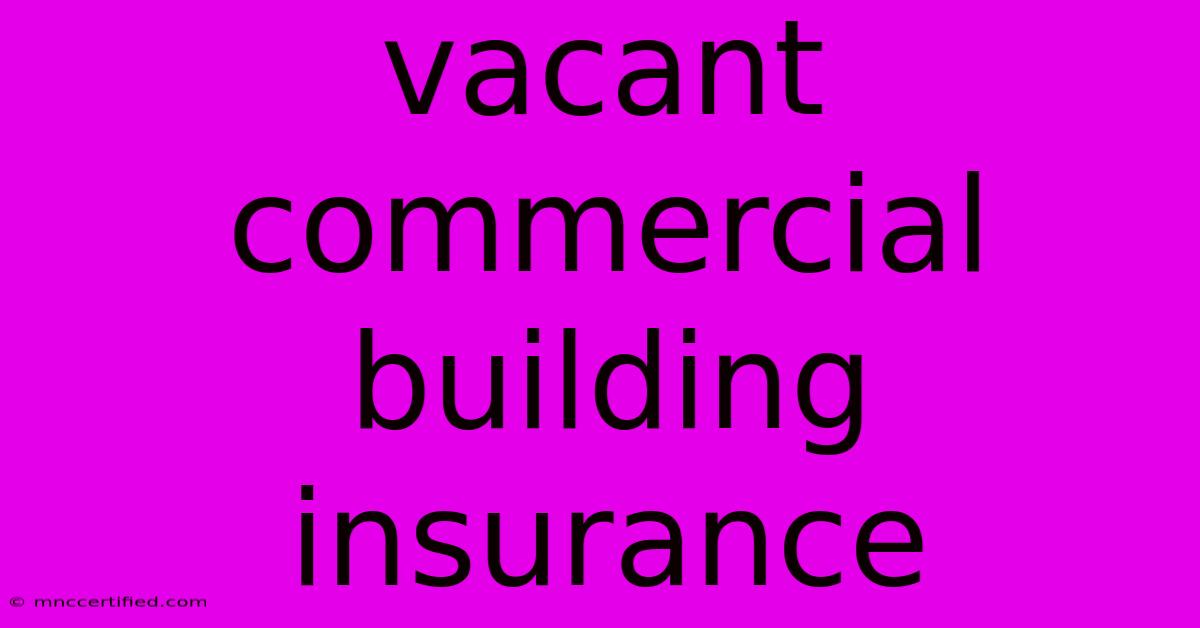Vacant Commercial Building Insurance

Table of Contents
Protecting Your Empty Investment: Vacant Commercial Building Insurance
Owning a commercial building can be a significant investment, but what happens when it sits vacant? This period of inactivity doesn't mean your responsibilities disappear. In fact, it often increases your risk. Vacant commercial building insurance is specifically designed to protect your property during this vulnerable stage.
Why is Vacant Commercial Building Insurance Important?
Empty buildings are more susceptible to a variety of risks compared to occupied ones:
- Increased risk of vandalism and theft: Without regular activity and security presence, vacant buildings are easy targets for criminals.
- Damage from weather events: Unmaintained roofs, broken windows, and inadequate drainage can lead to significant damage from rain, snow, or wind.
- Liability issues: Even unoccupied, your property can still pose liability risks, such as injuries from falling debris or faulty structures.
- Reduced value: Prolonged vacancy can deteriorate the building's condition, impacting its resale value.
What Does Vacant Commercial Building Insurance Cover?
While policies vary, standard coverage often includes:
- Property damage: This covers damage from fire, vandalism, theft, weather events, and other perils.
- Liability: Provides protection against lawsuits resulting from accidents on the property.
- Loss of income: This covers potential income loss if the property is damaged and unable to generate revenue.
- Additional coverages: Options like building code upgrades, environmental clean-up, and debris removal may be available.
How is Vacant Commercial Building Insurance Different?
Standard commercial property insurance may not offer adequate protection for vacant buildings. Vacant commercial building insurance differs in several key ways:
- Higher premiums: Due to the increased risk, premiums for vacant building policies are generally higher.
- Specific requirements: Policies often require regular inspections and maintenance to ensure the building's safety.
- Limited coverage: Some policies may have limitations on specific perils or coverage amounts.
Finding the Right Vacant Commercial Building Insurance
Here's a guide to help you secure the right coverage:
- Assess your risks: Consider the specific hazards your property faces, such as location, weather conditions, and potential for vandalism.
- Compare quotes: Obtain quotes from multiple insurers to compare coverage, premiums, and policy terms.
- Understand exclusions: Be aware of any specific exclusions or limitations in the policy.
- Choose a reputable insurer: Select a carrier with a strong track record of claims handling and customer service.
Maintaining Your Vacant Building
Even with insurance, proactive measures are crucial to protect your investment:
- Regular inspections: Schedule regular inspections to identify and address potential issues before they escalate.
- Security measures: Install security systems, cameras, and adequate lighting to deter criminals.
- Maintain utilities: Keep essential utilities, such as water and electricity, operational and properly monitored.
- Prevent water damage: Address any potential leaks promptly and ensure proper drainage.
Conclusion
Vacant commercial building insurance provides critical protection for your empty investment, mitigating financial losses and safeguarding your property from unforeseen events. By understanding the risks, comparing policies, and taking proactive measures, you can ensure your building is secured during its vacant period, providing peace of mind and protecting your valuable asset.

Thank you for visiting our website wich cover about Vacant Commercial Building Insurance. We hope the information provided has been useful to you. Feel free to contact us if you have any questions or need further assistance. See you next time and dont miss to bookmark.
Featured Posts
-
Real Sociedad Vs Barcelona Live Stream
Nov 11, 2024
-
Paddy Mc Guinnesss Children In Need Cycle Ride
Nov 11, 2024
-
Anatoliy Trubin In Goal For Shakhtar Vs Porto
Nov 11, 2024
-
1996 Vs Today Cowboys Super Bowl Gap
Nov 11, 2024
-
Liverpool Wsl Home Away From Home In St Helens
Nov 11, 2024